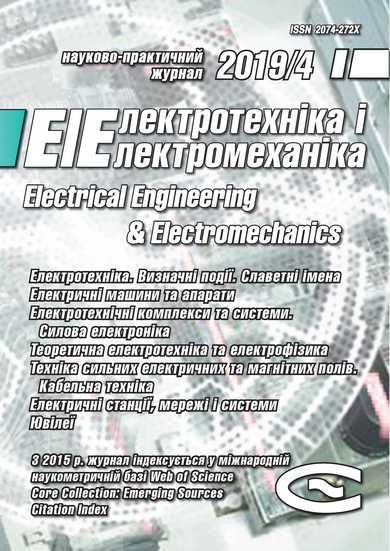TECHNOLOGICAL MONITORING OF ELECTRICAL RESISTANCE OF PRESSED CABLE CONDUCTORS IN PRODUCTION CONDITIONS
DOI:
https://doi.org/10.20998/2074-272X.2019.4.07Keywords:
control of electrical resistance, aluminum cable conductors, technological monitoring, probability of claims, mathematical apparatus of boundary distributionsAbstract
This paper presents results of control of electrical resistance R production pressed aluminum cable conductors. Control of electrical resistance in manufacturing of cable production is the most massive non-destructive test, which provides a compromise between the manufacturer's costs for a high-conductivity material on the one hand and the user's operating costs from conducting heating losses on the other. For the adoption of technological solutions for the use of hot compression of solid aluminum wires (instead of cold drawing technology) for a specific size, a reliable determination of the probability of unacceptable values of electrical resistance R > Ř (probability of claims) in large masses of products is necessary. The application of statistical analysis of measurement results using the mathematical apparatus of boundary distributions is considered. In this case, the subject matter of the analysis is the distribution of the limit values of the control parameter, which makes it possible to reliably estimate the likelihood of the appearance of inadmissible values (probability of claims). An algorithm for determining the probability of the appearance of impermissible values of the electrical resistance R > Ř (probability of claims) for solid aluminum wires of low and medium voltage cables in the range of the cross-sectional area (120...240) mm2 based on the analysis of the results of control of the electrical resistance during a long technological period (18 months) manufacturing in production conditions. The use of the appeal potential of the technological solution as the cost of products, for which R > Ř is used, is proposed. The comparison of the appeal potential of the technology of hot pressing of solid aluminum and the technology of cold drawing (dragging) provided the same level of specific electrical conductivity of the metal is achieved.References
Karpushenko V.P., Shchebeniuk L.A., Antonets Yu.O., Naumenko O.A. Sylovi kabeli nyz'koyi ta seredn'oyi napruhy. Konstruyuvannya, tekhnolohiya, yakist' [Power cables of low and medium voltage. Designing, technology, quality]. Kharkiv, Region-inform Publ., 2000. 376 p. (Ukr).
Zolotaryov V.M., Antonets Yu.P., Antonets S.Yu., Golik O.V., Shchebeniuk L.A. Online technological monitoring of insulation defects in enameled wires. Electrical engineering & electromechanics, 2017, no.4, pp. 55-60. doi: 10.20998/2074-272X.2017.4.09.
Golik O.V. Statistical procedures for two-sided limit of a controlled parameter in the process of production of cable and wire products. Electrical Engineering & Electromechanics, 2016, no.5, pp. 47-50. (Rus). doi: 10.20998/2074-272X.2016.5.07.
Gnedenko B.V., Belyaev Yu.O., Solovjev A.D. Matematicheskie metody v teorii nadezhnosti [Mathematical methods in theory of reliability].Moscow, Nauka Publ., 1965. 524 p. (Rus).
Bauser M., Sauer G., Siegert K. Pressovanie [Pressing].Moscow, Alumsil MViT Publ., 2009. 922 p. (Rus).
Kuznetsov V.P. Interval'nye statisticheskie modeli [Interval statistical models]. Moscow, Radio i sviaz' Publ., 1991. 352 p. (Rus).
Tutubalin V.N. Granitsy primenimosti [Limits of application]. Moscow, Znanie Publ., 1977. 64 p. (Rus).
Shchebeniuk L.A., Golik O.V. Matematychni osnovy nadiynosti izolyatsiyi elektroobladnannya [Mathematical foundations of the reliability of electrical insulation]. Kharkiv, NTU «KhPI» Publ., 2003. 102 p. (Ukr).
Downloads
Published
How to Cite
Issue
Section
License
Copyright (c) 2019 Y. A. Antonets, L. A. Shchebeniuk, O. M. Grechko

This work is licensed under a Creative Commons Attribution-NonCommercial 4.0 International License.
Authors who publish with this journal agree to the following terms:
1. Authors retain copyright and grant the journal right of first publication with the work simultaneously licensed under a Creative Commons Attribution License that allows others to share the work with an acknowledgement of the work's authorship and initial publication in this journal.
2. Authors are able to enter into separate, additional contractual arrangements for the non-exclusive distribution of the journal's published version of the work (e.g., post it to an institutional repository or publish it in a book), with an acknowledgement of its initial publication in this journal.
3. Authors are permitted and encouraged to post their work online (e.g., in institutional repositories or on their website) prior to and during the submission process, as it can lead to productive exchanges, as well as earlier and greater citation of published work.





